What Does it Take to Be a Human Factors Engineer or Ergonomist?
Occupation Description Design objects, facilities, and environments to optimize human well-being and overall system performance, applying theory, principles, and data regarding the relationship between humans and respective technology. Investigate and analyze characteristics of human behavior and performance as it relates to the use of technology.
What Do Human Factors Engineers and Ergonomists Do On a Daily Basis?
- Conduct research to evaluate potential solutions related to changes in equipment design, procedures, manpower, personnel, or training.
- Analyze complex systems to determine potential for further development, production, interoperability, compatibility, or usefulness in a particular area, such as aviation.
- Investigate theoretical or conceptual issues, such as the human design considerations of lunar landers or habitats.
- Design or evaluate human work systems, using human factors engineering and ergonomic principles to optimize usability, cost, quality, safety, or performance.
- Advocate for end users in collaboration with other professionals, including engineers, designers, managers, or customers.
- Develop or implement human performance research, investigation, or analysis protocols.
Featured schools near , edit
Human Factors Engineer or Ergonomist Needed Skills
Human Factors Engineers and Ergonomists state the following job skills are important in their day-to-day work.
Critical Thinking: Using logic and reasoning to identify the strengths and weaknesses of alternative solutions, conclusions or approaches to problems.
Complex Problem Solving: Identifying complex problems and reviewing related information to develop and evaluate options and implement solutions.
Active Listening: Giving full attention to what other people are saying, taking time to understand the points being made, asking questions as appropriate, and not interrupting at inappropriate times.
Speaking: Talking to others to convey information effectively.
Reading Comprehension: Understanding written sentences and paragraphs in work related documents.
Writing: Communicating effectively in writing as appropriate for the needs of the audience.
Types of Human Factors Engineer or Ergonomist
- Human Factors Engineer
- President Ergonomic Consulting
- Senior Research Associate
- Chief Engineer
- Ergonomic Specialist
Job Outlook for Human Factors Engineers and Ergonomists
In the United States, there were 257,900 jobs for Human Factors Engineer or Ergonomist in 2016. New jobs are being produced at a rate of 9.7% which is above the national average. The Bureau of Labor Statistics predicts 25,100 new jobs for Human Factors Engineer or Ergonomist by 2026. Due to new job openings and attrition, there will be an average of 19,700 job openings in this field each year.
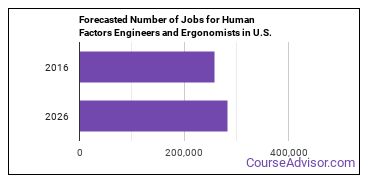
The states with the most job growth for Human Factors Engineer or Ergonomist are Nevada, Utah, and Alabama. Watch out if you plan on working in New Mexico, Vermont, or Maryland. These states have the worst job growth for this type of profession.
Human Factors Engineer or Ergonomist Average Salary
The average yearly salary of a Human Factors Engineer or Ergonomist ranges between $56,470 and $132,340.
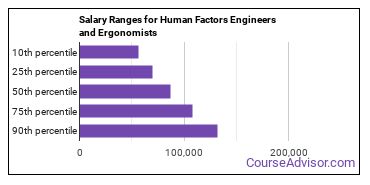
Human Factors Engineers and Ergonomists who work in Wyoming, Washington, or Texas, make the highest salaries.
Below is a list of the median annual salaries for Human Factors Engineers and Ergonomists in different U.S. states.
| State | Annual Mean Salary |
|---|---|
| Alabama | $87,870 |
| Arizona | $95,940 |
| Arkansas | $77,100 |
| California | $107,810 |
| Colorado | $100,460 |
| Connecticut | $89,830 |
| Delaware | $94,590 |
| District of Columbia | $88,380 |
| Florida | $77,410 |
| Georgia | $86,220 |
| Hawaii | $95,590 |
| Idaho | $94,830 |
| Illinois | $88,850 |
| Indiana | $74,430 |
| Iowa | $82,770 |
| Kansas | $79,580 |
| Kentucky | $79,170 |
| Louisiana | $99,090 |
| Maine | $88,020 |
| Maryland | $102,200 |
| Massachusetts | $102,210 |
| Michigan | $89,330 |
| Minnesota | $90,580 |
| Mississippi | $82,040 |
| Missouri | $87,620 |
| Montana | $100,640 |
| Nebraska | $85,950 |
| Nevada | $87,140 |
| New Hampshire | $91,530 |
| New Jersey | $98,050 |
| New Mexico | $102,120 |
| New York | $94,700 |
| North Carolina | $87,110 |
| North Dakota | $79,980 |
| Ohio | $84,060 |
| Oklahoma | $85,280 |
| Oregon | $90,980 |
| Pennsylvania | $86,080 |
| Rhode Island | $97,610 |
| South Carolina | $87,080 |
| South Dakota | $82,780 |
| Tennessee | $84,070 |
| Texas | $109,880 |
| Utah | $89,830 |
| Vermont | $79,700 |
| Virginia | $93,980 |
| Washington | $106,980 |
| West Virginia | $94,480 |
| Wisconsin | $77,260 |
| Wyoming | $102,730 |
Tools & Technologies Used by Human Factors Engineers and Ergonomists
Although they’re not necessarily needed for all jobs, the following technologies are used by many Human Factors Engineers and Ergonomists:
- Microsoft Excel
- Microsoft Word
- Microsoft Office
- Hypertext markup language HTML
- JavaScript
- Microsoft PowerPoint
- jQuery
- Microsoft Visio
- Adobe Systems Adobe Photoshop
- The MathWorks MATLAB
- SAS
- Microsoft Visual Basic
- Adobe Systems Adobe Illustrator
- IBM SPSS Statistics
- Computer aided design CAD software
- National Instruments LabVIEW
- Microsoft Internet Explorer
- Adobe Systems Adobe Dreamweaver
- Dassault Systemes CATIA
- Adobe Systems Adobe Flash
How do I Become a Human Factors Engineer or Ergonomist?
What kind of Human Factors Engineer or Ergonomist requirements are there?
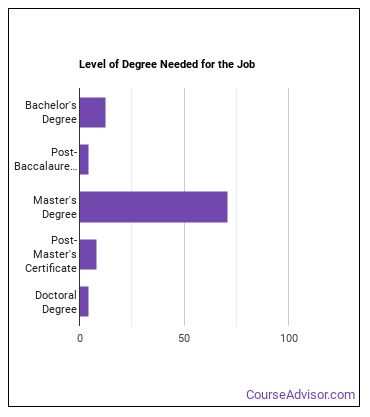
How Long Does it Take to Become a Human Factors Engineer or Ergonomist?
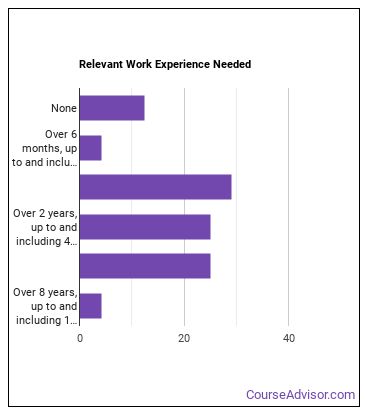
Who Employs Human Factors Engineers and Ergonomists?
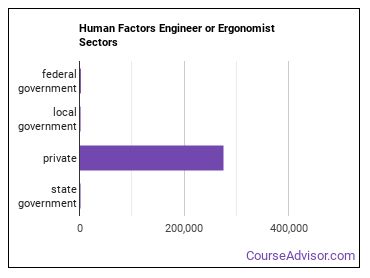
The table below shows the approximate number of Human Factors Engineers and Ergonomists employed by various industries.
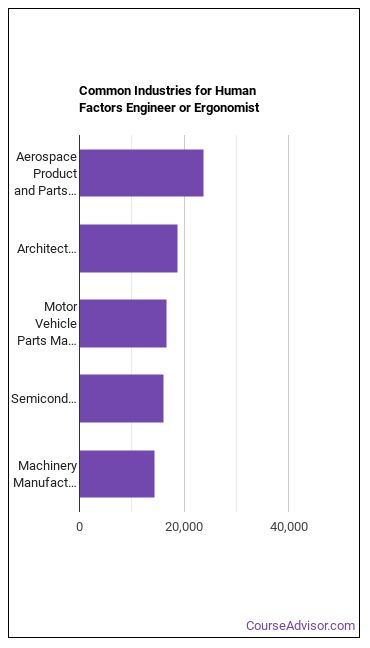
References:
Image Credit:
More about our data sources and methodologies.
Featured Schools
 Request Info
Request Info
|
Southern New Hampshire University You have goals. Southern New Hampshire University can help you get there. Whether you need a bachelor's degree to get into a career or want a master's degree to move up in your current career, SNHU has an online program for you. Find your degree from over 200 online programs. Learn More > |
